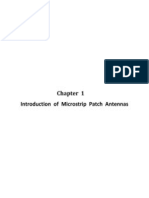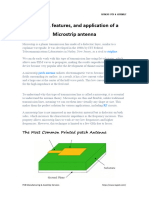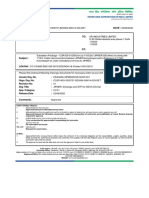Micro Strip 1
Micro Strip 1
Uploaded by
Narender Reddy KampelliCopyright:
Available Formats
Micro Strip 1
Micro Strip 1
Uploaded by
Narender Reddy KampelliOriginal Description:
Copyright
Available Formats
Share this document
Did you find this document useful?
Is this content inappropriate?
Copyright:
Available Formats
Micro Strip 1
Micro Strip 1
Uploaded by
Narender Reddy KampelliCopyright:
Available Formats
Leccture--1
MIC
CROST
TRIP ANTEN
A NNAS
5.1 Intrroduction::
Microstripp Antenna (M MSA) in its sim mplest config
guration (fig.55.1) consists of a radiatingg patch on onne side
of a dieleectric substratte ( r 10 ), and has a ground
g plane on the otherr side. The patch conducttors is
normally of copper orr gold. The dielectric
d consstant of the ssubstrate shouuld be low ( r 2.5 ), so as to
he fringe field
enhance th ds which acco
ount for the raadiation.
With resp pect to radiaation properties these anttennas are vversatile in tterms of resoonant frequeencies,
polarizatio
on, pattern and
a impedancce. They allo ow the use oof additionall tuning elem ments like piins or
varactor diodes
d betweeen the patch and
a the groun nd plane. The choice of thee substrate is very much liimited
by the miccrowave circu uit coupled to
o the antenna,, which has too be built on tthe same boarrd. The microowave
circuit tog
gether with th
he antenna is usually
u manufactured by pphoto-etchingg technology.
Fig.5.1 Microstrip
M anteenna Configurration
5.1.1 Ad
dvantages of
o microstrrip antenna
a:
Microstrip
p antenna has several advantages
a compared to conventionaal microwavee antennas. T These
antennas are
a used in many
m applicatiions over the broad frequeency range froom 100MHz tto 50GHz.
Some of the
t principal advantages
a off these antenn
nas are:
Loow weight, low w cost, low profile
p and con
nformal
Eaasy to fabricatte and can be integrated wiith other micrrostrip compoonents in monnolithic appliccation
lik
ke RFIC and MMIC.
M
Thhe antenna can n be easily mounted
m on missiles,
m rockeets and satellitte without maajor alterationns.
Thhe antenna has low scatteriing cross section.
Duual frequencyy antenna can be easily mad de.
Microstrip antennas are compatible with modular designs (Solid state devices such as oscillators,
amplifiers, variable attenuators, mixer, phase shifters ete. can be added directly to the antenna
substrate board)
5.1.2 Disadvantages:
Narrow bandwidth
Radiation efficiency deteriorates as frequency and antenna array size increases due to an increase
in the feeding network losses.
Lower power handling capacity
Poor isolation between the feed and the radiating elements
In recent years, with the advancement of technology, efforts have been made to minimize these effects
dramatically.
5.1.3 Applications of MSA
For many practical designs, the advantages of MSA far outweigh their disadvantages. With continuous
research and development, the microstrip antennas have been applied in many different and successful
applications. Now a days it is the most popular antenna in the wireless communication market. We can
find applications of MSA in many various fields of high-tech technology which includes:
Satellite communication
Mobile communication
Missile telemetry
Biomedical radiator
Radar system
Radio altimeter
5.2 Microstrip antenna configurations:
Microstrip antennas are characterized by their physical parameters. They may be of any geometrical
shape and any dimension. However all the microstrip antennas can broadly be divided into three basic
categories: (i) microstrip patch antenna, (ii) microstrip traveling-wave antennas, (iii) microstrip slot
antennas.
(i) Microstrip patch antenna
Microstrip patch antenna consists of a conducting patch of any planar geometry on one side of a
dielectric substrate backed by a ground plane on the other side. There are virtually an unlimited umber of
patch patterns for which the radiation characteristics may be calculated. Fig. 5.2 shows some common
patch configuration.
(ii) Microstrip traveling-wave antenna
Microstrip traveling-wave antennas consists of chain-shaped periodic conductors or an ordinary long
TEM line which also supports a TE mode, on a substrate backed by a ground plane. The open end of the
TEM line is terminate in a matched resistive load. As antennas support traveling waves, their structures
may be designed so that the main beam lies in any direction from broadside to endfire. Various
configurations of microstrip traveling-wave antenna are shown in fig.5.3
(iii) Microstrip slot anntenna
Microstrip o a slot in thee ground planne fed by a miicrostrip line. The slot mayy have
p slot antennaas comprise of
the shape of a rectanglee (narrow or wide),
w a circle or an annuluus as shown iin fig 5.4.
Fig.5.2 Various
V Micro
ostrip patch an
ntenna config
guration
Fig.5.3 Microstrip
M trav
veling wave antenna
a
Fig.5.4 Microstrip
M slott antenna
You might also like
- Microstrip AntennasDocument13 pagesMicrostrip AntennasIgor CarneiroNo ratings yet
- Product SpecificationDocument38 pagesProduct SpecificationGlauber OliveiraNo ratings yet
- 09 - Chapter 3Document35 pages09 - Chapter 3manojreddy8546No ratings yet
- Appli and TypesDocument5 pagesAppli and Typessuhag_73No ratings yet
- Mna Cep.Document7 pagesMna Cep.Mustafa Fazal AbbasNo ratings yet
- Hota 2017Document7 pagesHota 2017Ahlam BOUANINo ratings yet
- IJSRDV2I123243Document5 pagesIJSRDV2I123243sreelakshmi.ece eceNo ratings yet
- A Miniature Microstrip Patch Antenna Array With Defected Ground StructureDocument8 pagesA Miniature Microstrip Patch Antenna Array With Defected Ground StructurePadmasreeNo ratings yet
- Advance Antenna System (ECE-6208)Document23 pagesAdvance Antenna System (ECE-6208)Deepak RasailyNo ratings yet
- Bandwidth Optimization of Microstrip Patch Antenna-A Basic OverviewDocument11 pagesBandwidth Optimization of Microstrip Patch Antenna-A Basic OverviewEditor IJRITCCNo ratings yet
- Outlines: Presented byDocument22 pagesOutlines: Presented byRAJESHWARI MNo ratings yet
- Outlines: Presented byDocument22 pagesOutlines: Presented byAkhmad Hafid IrawanNo ratings yet
- 1.1 Trends in Antennas For Wireless CommunicationDocument32 pages1.1 Trends in Antennas For Wireless CommunicationbabuNo ratings yet
- Resumo BoomDocument4 pagesResumo BoomAml LimaNo ratings yet
- A Design Rule For Inset-Fed Rectangular MicrostripDocument11 pagesA Design Rule For Inset-Fed Rectangular MicrostripKartik GoyalNo ratings yet
- Tech RPRTDocument17 pagesTech RPRTthejasNo ratings yet
- Ch-14 Microstrip AntennaDocument42 pagesCh-14 Microstrip AntennaMahy MagdyNo ratings yet
- Modified Rectangular Patch Antenna With Semicircular Arcs Loaded Dgs For Uwb CommunicationsDocument51 pagesModified Rectangular Patch Antenna With Semicircular Arcs Loaded Dgs For Uwb CommunicationsvenkyNo ratings yet
- MS Antenna Array PDFDocument3 pagesMS Antenna Array PDFjenath1No ratings yet
- Final PPT AmarDocument21 pagesFinal PPT Amarashishvasekar0% (1)
- Chapter IntroductionDocument1 pageChapter IntroductionJyothi JoNo ratings yet
- IJETR2282Document4 pagesIJETR2282anil kasotNo ratings yet
- Circularly Polarized Circular Patch Antenna With Coplanar Parasitic ElementsDocument4 pagesCircularly Polarized Circular Patch Antenna With Coplanar Parasitic ElementseditorinchiefijcsNo ratings yet
- Lens AntennaDocument6 pagesLens Antennamanjutc000No ratings yet
- Types of Antenna (Sir)Document9 pagesTypes of Antenna (Sir)Muhammad AbdullahNo ratings yet
- Finel PresentationDocument51 pagesFinel Presentationtamem shamhanNo ratings yet
- Screen-Printed, Flexible, Parasitic Beam-Switching Millimeter-Wave Antenna Array For Wearable ApplicationsDocument9 pagesScreen-Printed, Flexible, Parasitic Beam-Switching Millimeter-Wave Antenna Array For Wearable Applicationsantonio ScacchiNo ratings yet
- Arun Verma ThesisDocument61 pagesArun Verma ThesisArun SharmaNo ratings yet
- Project AntennaDocument13 pagesProject AntennaSai kumarNo ratings yet
- 829-Research Article-3061-2-10-20181209Document6 pages829-Research Article-3061-2-10-20181209Harini VemulaNo ratings yet
- Antenna ResearcgDocument7 pagesAntenna ResearcgArshnoor SinghNo ratings yet
- Miniaturized Dual Band Triangular Microstrip Antenna With Sierpinski Fractal GroundDocument9 pagesMiniaturized Dual Band Triangular Microstrip Antenna With Sierpinski Fractal Groundha naruNo ratings yet
- Antena MikrostripDocument44 pagesAntena MikrostripAdmin EngineerNo ratings yet
- Multiple Patch Antenna System For Wireless Applications: Vivek Ram, Vandit Anjaria, Punit Boriya, Khushbu MehtaDocument5 pagesMultiple Patch Antenna System For Wireless Applications: Vivek Ram, Vandit Anjaria, Punit Boriya, Khushbu MehtaresearchinventyNo ratings yet
- A Microstripe Slotted Patch Antenna Using Amc: Manju Saini, Sachin Singla, Koneesh AggarwalDocument5 pagesA Microstripe Slotted Patch Antenna Using Amc: Manju Saini, Sachin Singla, Koneesh AggarwalNag ChallaNo ratings yet
- Term PaperDocument63 pagesTerm PaperSarath BabuNo ratings yet
- Dual Frequency Hexagonal Microstrip Patc PDFDocument9 pagesDual Frequency Hexagonal Microstrip Patc PDFSai TejaNo ratings yet
- Final MTech ProjectDocument30 pagesFinal MTech ProjectArunSharmaNo ratings yet
- Compact Offset Microstrip-Fed MIMO Antenna For Band-Notched UWB ApplicationsDocument4 pagesCompact Offset Microstrip-Fed MIMO Antenna For Band-Notched UWB ApplicationsAbdullah MadniNo ratings yet
- Ijcea TJ 02 34Document13 pagesIjcea TJ 02 34biplabsahoo10No ratings yet
- Microstrip Patch Antenna: A Survey: Arun Kumar Sharma, 1st (Author) Danveer Mandal, 2nd (Author)Document4 pagesMicrostrip Patch Antenna: A Survey: Arun Kumar Sharma, 1st (Author) Danveer Mandal, 2nd (Author)Vikas SinghNo ratings yet
- Review of Some Investigations On Rectangular Microstrip Antennas With Embedded SlotsDocument8 pagesReview of Some Investigations On Rectangular Microstrip Antennas With Embedded SlotsInternational Journal of Application or Innovation in Engineering & ManagementNo ratings yet
- Kumar 2018Document5 pagesKumar 2018PRASANTH KUMAR JNo ratings yet
- RMPA Using Dielectric Optimization TechniqueDocument4 pagesRMPA Using Dielectric Optimization TechniqueijsretNo ratings yet
- Butterfly Shaped Printed Monopole Antenna For Ultra Wide Band ApplicationsDocument7 pagesButterfly Shaped Printed Monopole Antenna For Ultra Wide Band ApplicationsKumarNo ratings yet
- Aperture Coupled Rectangular Microstrip Patch Antenna For SDocument9 pagesAperture Coupled Rectangular Microstrip Patch Antenna For SBrijesh SoniNo ratings yet
- Chapter 2Document22 pagesChapter 2NAMIRA CHOWDHURYNo ratings yet
- Benefits, Features, and Application of A Microstrip AntennaDocument12 pagesBenefits, Features, and Application of A Microstrip AntennajackNo ratings yet
- Simulation of A Rectangular Patch AntennaDocument9 pagesSimulation of A Rectangular Patch AntennaragvshahNo ratings yet
- D59988fa PDFDocument13 pagesD59988fa PDFAlagu MurugesanNo ratings yet
- Design Development of Antenna For TV Transmission For Connecting Outdoor Broadcasts Van To The Studio For Rural AreasDocument6 pagesDesign Development of Antenna For TV Transmission For Connecting Outdoor Broadcasts Van To The Studio For Rural AreasSwati PugaliaNo ratings yet
- Antenna Parameter AssignmentDocument10 pagesAntenna Parameter AssignmentMelaku NegussieNo ratings yet
- Modifided Fork Shaped Ultra-Wideband Antenna: Pawan Mahicha, Girish Awadhawal, M. K. MeshramDocument4 pagesModifided Fork Shaped Ultra-Wideband Antenna: Pawan Mahicha, Girish Awadhawal, M. K. MeshrammanojNo ratings yet
- Cicn 2014Document6 pagesCicn 2014EfriliaMKhusnaNo ratings yet
- Tesi Mauro Pelosi Antenne StampateDocument87 pagesTesi Mauro Pelosi Antenne StampateLuigi ReveruzziNo ratings yet
- Design & Simulation of 8-Shape MPADocument7 pagesDesign & Simulation of 8-Shape MPASohag Kumar SahaNo ratings yet
- Microstrip and Printed Antennas: New Trends, Techniques and ApplicationsFrom EverandMicrostrip and Printed Antennas: New Trends, Techniques and ApplicationsDebatosh GuhaRating: 4 out of 5 stars4/5 (1)
- Millimetre Wave Antennas for Gigabit Wireless Communications: A Practical Guide to Design and Analysis in a System ContextFrom EverandMillimetre Wave Antennas for Gigabit Wireless Communications: A Practical Guide to Design and Analysis in a System ContextNo ratings yet
- Radio Frequency Identification and Sensors: From RFID to Chipless RFIDFrom EverandRadio Frequency Identification and Sensors: From RFID to Chipless RFIDNo ratings yet
- ELECTRONICSANDCOMMUNICATIONENGINEERINGDocument119 pagesELECTRONICSANDCOMMUNICATIONENGINEERINGNarender Reddy KampelliNo ratings yet
- Ug Sar Tier I Final Ver 1.0 PDFDocument43 pagesUg Sar Tier I Final Ver 1.0 PDFNarender Reddy KampelliNo ratings yet
- Internet of Things (Iot) : A Brief Information and Challenges of ImplementingDocument3 pagesInternet of Things (Iot) : A Brief Information and Challenges of ImplementingNarender Reddy KampelliNo ratings yet
- Project B.TechDocument5 pagesProject B.TechNarender Reddy KampelliNo ratings yet
- Hardware Based Design and Implementation of A BottleDocument23 pagesHardware Based Design and Implementation of A BottleNarender Reddy KampelliNo ratings yet
- High EduDocument74 pagesHigh EduNarender Reddy KampelliNo ratings yet
- A.P Fee Reg CommitteeDocument7 pagesA.P Fee Reg CommitteeNarender Reddy KampelliNo ratings yet
- Application FormDocument1 pageApplication FormNarender Reddy KampelliNo ratings yet
- 2019 Winter Model Answer Paper (Msbte Study Resources)Document16 pages2019 Winter Model Answer Paper (Msbte Study Resources)juber mullaNo ratings yet
- Electro LecturesDocument49 pagesElectro LecturesEnock SamuelNo ratings yet
- Cayin iDAC-6 User ManualDocument11 pagesCayin iDAC-6 User ManualOscar Cortes EscrivaNo ratings yet
- Price Fokus 2015 (Print)Document10 pagesPrice Fokus 2015 (Print)ariotwNo ratings yet
- Data - Sheet - Enblock C6.5 - Ver3.0Document3 pagesData - Sheet - Enblock C6.5 - Ver3.0paoly44No ratings yet
- 50kva DG Set 1 Cat I ApprovalDocument25 pages50kva DG Set 1 Cat I ApprovalPraveen ThakurNo ratings yet
- Ee0041l-Finals (Sa) VillanuevaDocument86 pagesEe0041l-Finals (Sa) VillanuevaKYLE LEIGHZANDER VICENTENo ratings yet
- Electrical System Routine Checking Schedule: To Be Checked in "A" ShiftDocument1 pageElectrical System Routine Checking Schedule: To Be Checked in "A" Shiftjp mishraNo ratings yet
- FFFFDocument1 pageFFFFDerf Jayson AdanteNo ratings yet
- Internship Report SubstationDocument6 pagesInternship Report SubstationSAJEEVAN TNo ratings yet
- Digital Integrated Circuits: A Design PerspectiveDocument15 pagesDigital Integrated Circuits: A Design PerspectiveIan PressNo ratings yet
- Pneumatics Activity 2Document2 pagesPneumatics Activity 2Jay Mark BalaneNo ratings yet
- SQB 405 SaqcnDocument8 pagesSQB 405 SaqcnMohammed SaeedNo ratings yet
- Rotary Switch AssembliesDocument2 pagesRotary Switch AssembliesninatenaNo ratings yet
- Unit-3 PsocDocument23 pagesUnit-3 PsocDESI BRAHMNNo ratings yet
- Airframe Electrical FAA QuestionsDocument5 pagesAirframe Electrical FAA QuestionsJAYACHANDRANNo ratings yet
- Diodo DamperDocument5 pagesDiodo DamperWinderson MacauranNo ratings yet
- Modeling Power System ComponentsDocument38 pagesModeling Power System ComponentsTanmay sahooNo ratings yet
- Datwiler Manual 2008 v3 enDocument57 pagesDatwiler Manual 2008 v3 enhjduarteNo ratings yet
- Physics - Mri Class 12 KashviDocument14 pagesPhysics - Mri Class 12 KashviKashvi DevNo ratings yet
- Jeep MetersDocument8 pagesJeep Metershenry307No ratings yet
- NDT (Non-Destructive Testing) : Critical InfrastructureDocument15 pagesNDT (Non-Destructive Testing) : Critical InfrastructureVasyl PanasyukNo ratings yet
- My TestDocument2 pagesMy TestLim Chin YangNo ratings yet
- Guidelines in EI InstallationDocument7 pagesGuidelines in EI Installationprasadgupta101102No ratings yet
- Optical FiberDocument18 pagesOptical FiberCSC LanjipadarNo ratings yet
- PACO Oscilloscope ES550B ManualDocument22 pagesPACO Oscilloscope ES550B Manualpepe sanchezNo ratings yet
- Principles of MriDocument28 pagesPrinciples of MriAbasiama UdemeNo ratings yet
- Sunfire Amplifier Whitepaper PDFDocument12 pagesSunfire Amplifier Whitepaper PDFDirk SloosNo ratings yet
- Durasol Models UpdateDocument14 pagesDurasol Models UpdateSoud AbdallahNo ratings yet

































































































